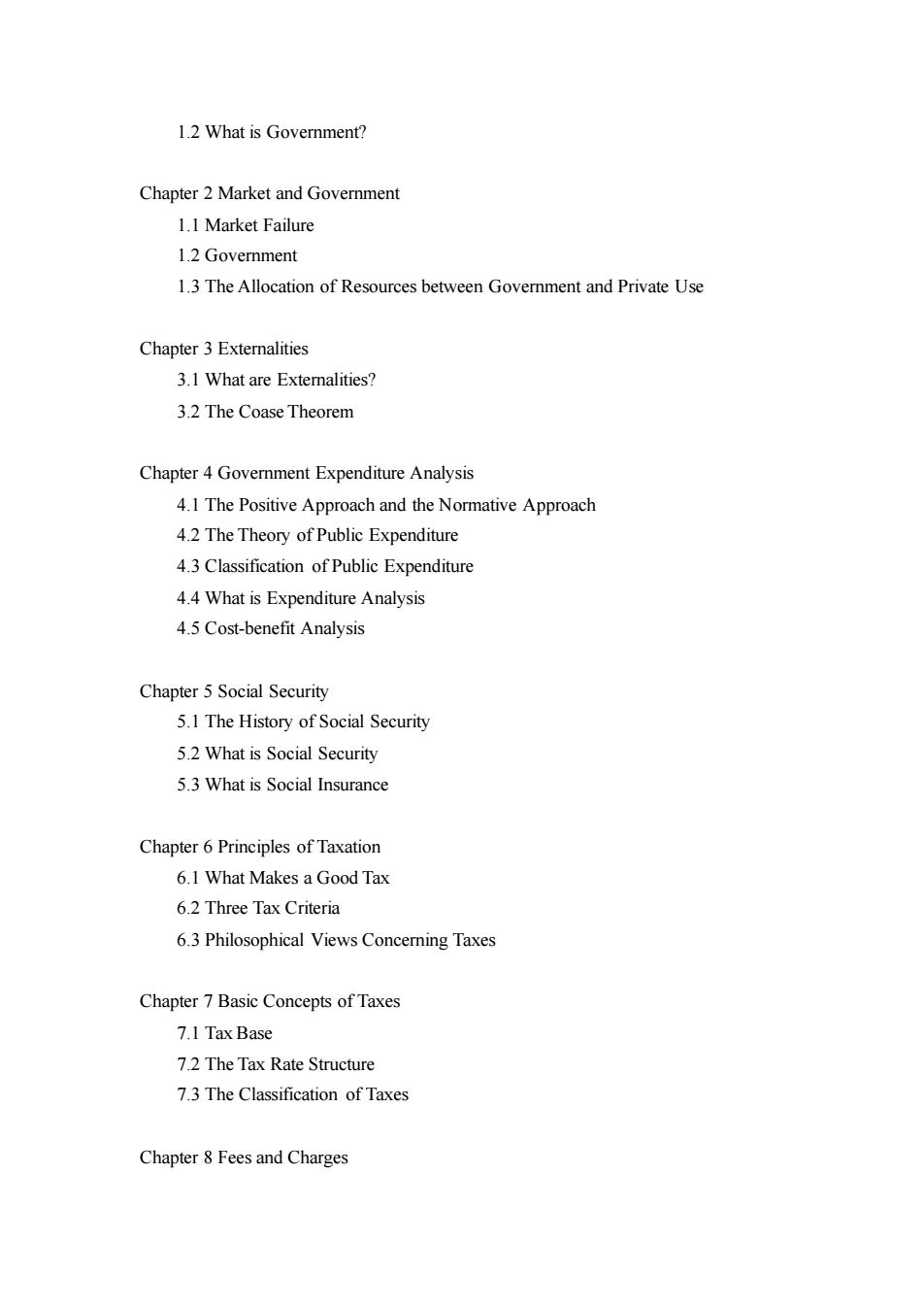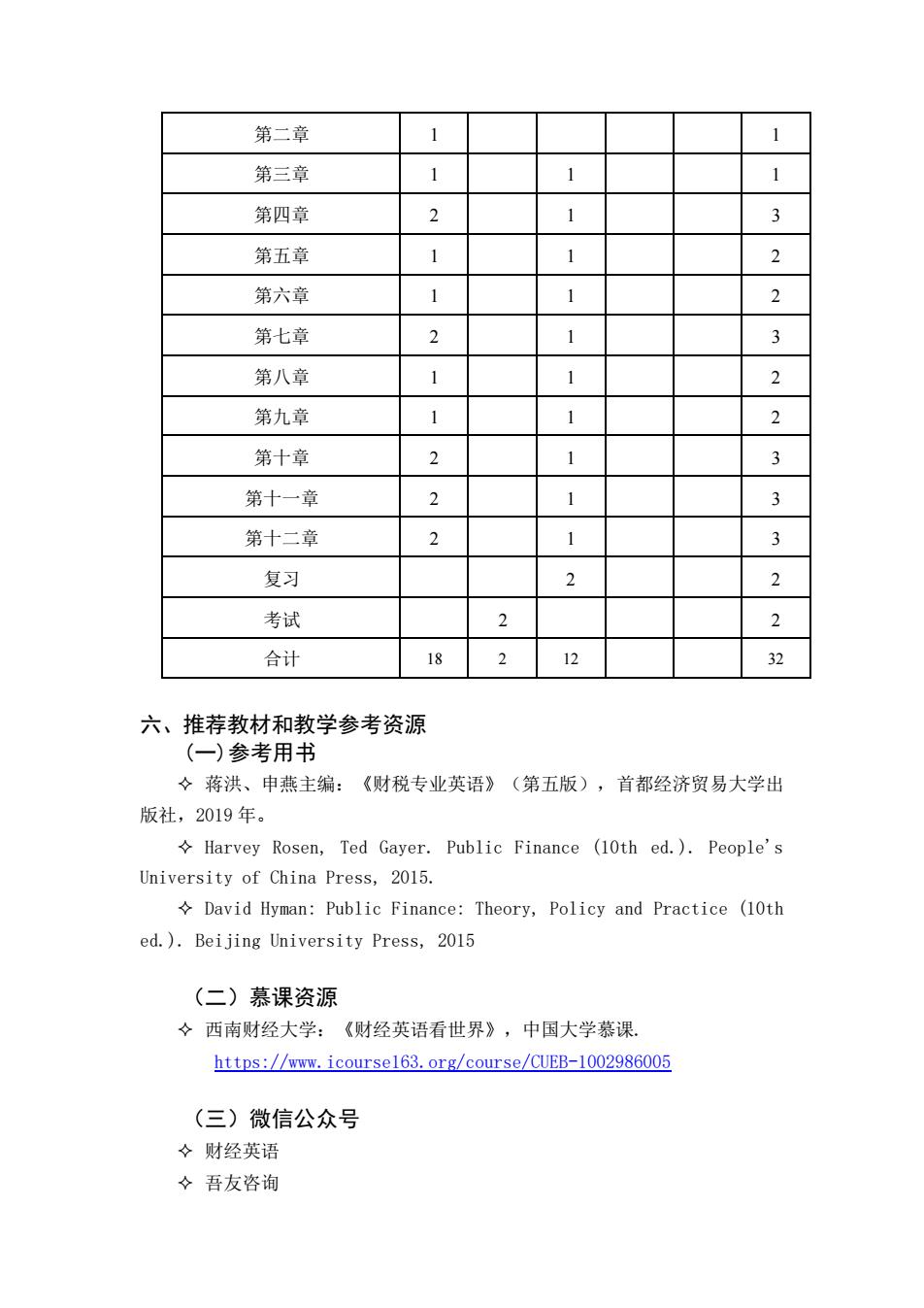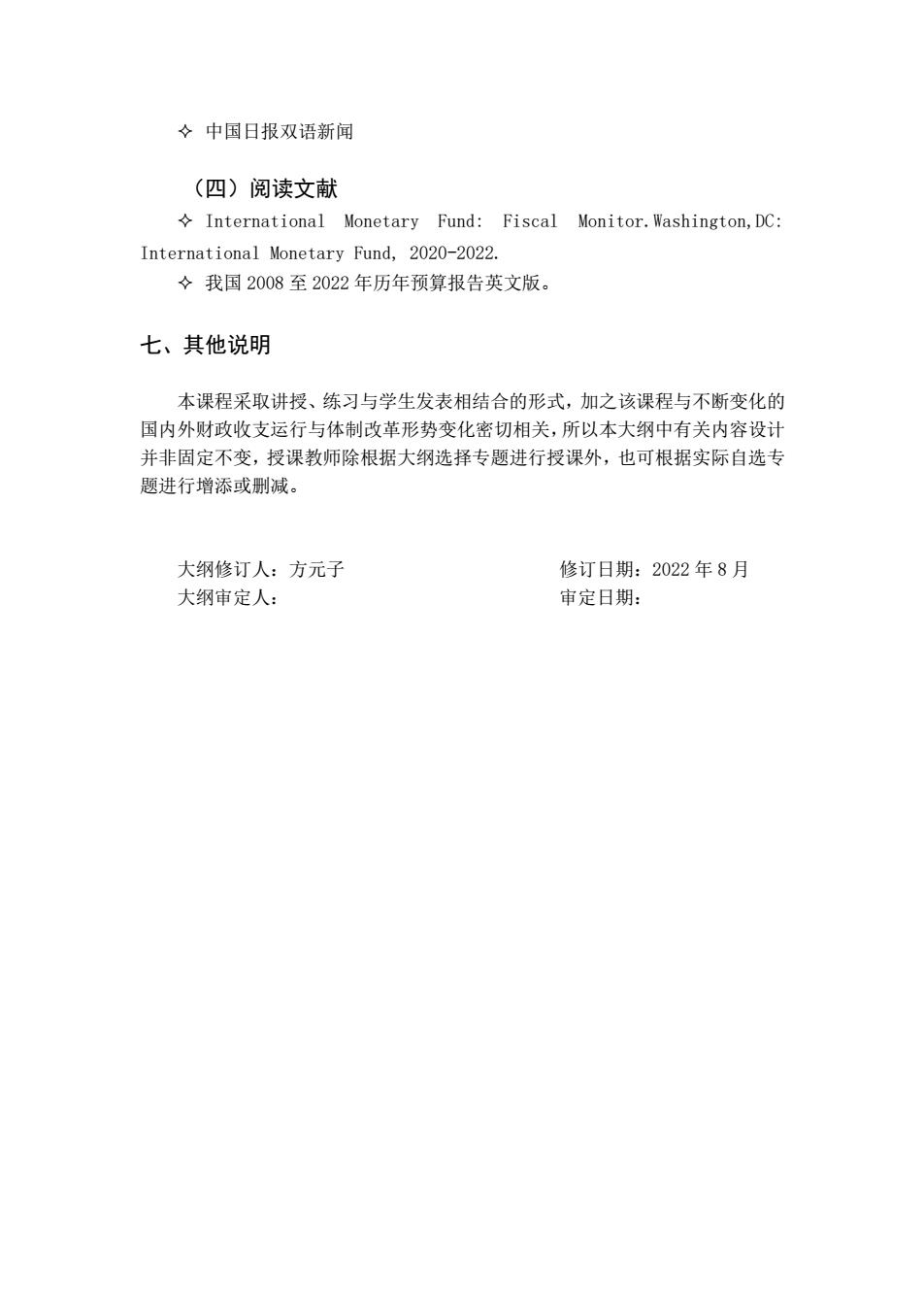
《财税英语》课程教学大纲 一、课程基本信息 课程代码:16009002 课程名称:财税英语 英文名称:Specialized English of Public Finance and Taxation 课程类别:专业课 学时:32 学分:2 适用对象:财政学类本科专业大三年级学生 考核方式:开卷考试 先修课程:《大学英语》、《财政学》 二、课程简介 本课程是针对财政学类专业高年级学生所开设的专业选修课程,结合对财税 方面英文资料的阅读、分析与比较,重点介绍财政学专业术语的英文表达。课程 内容主要包括财政学基础理论篇,财政支出篇、财政收入篇与财政管理篇等内容 模块。 三、课程性质与教学目的 本课程是财政学类专业选修课程之一。结合本专业培养高素质、复合型、国 际化的财税专业人才的目标定位与要求,本课程的教学目的主要有:(1)重点 使学生掌握对财政学基本概念、术语、原理的英文表达与深层次理解,把握国内 外财税理论与实践的发展脉络与前沿动态,拓宽知识面:(2)提高学生运用英 文进行专业交流的能力,培养英语思考的思维方式:(3)坚持财税专业素质与 人文素养并重,引导学生关注中国的大国实力和国际地位的提升,培养民族自豪 感:学习、宜传和贯彻中国特色社会主义公共财政理论与实践,坚定“四个自信”: 引导学生正确看待外媒涉华言论,明辨是非,理性分析中外思维差异,在此基础 上讲好中国故事,传播好中国声音。 四、教学内容 Chapter 1 Public Finance and Government 1.1 Public Finance and Ideology
《财税英语》课程教学大纲 一、课程基本信息 课程代码:16009002 课程名称:财税英语 英文名称:Specialized English of Public Finance and Taxation 课程类别:专业课 学 时:32 学 分:2 适用对象:财政学类本科专业大三年级学生 考核方式:开卷考试 先修课程:《大学英语》、《财政学》。 二、课程简介 本课程是针对财政学类专业高年级学生所开设的专业选修课程,结合对财税 方面英文资料的阅读、分析与比较,重点介绍财政学专业术语的英文表达。课程 内容主要包括财政学基础理论篇,财政支出篇、财政收入篇与财政管理篇等内容 模块。 三、课程性质与教学目的 本课程是财政学类专业选修课程之一。结合本专业培养高素质、复合型、国 际化的财税专业人才的目标定位与要求,本课程的教学目的主要有:(1)重点 使学生掌握对财政学基本概念、术语、原理的英文表达与深层次理解,把握国内 外财税理论与实践的发展脉络与前沿动态,拓宽知识面;(2)提高学生运用英 文进行专业交流的能力,培养英语思考的思维方式;(3)坚持财税专业素质与 人文素养并重,引导学生关注中国的大国实力和国际地位的提升,培养民族自豪 感;学习、宣传和贯彻中国特色社会主义公共财政理论与实践,坚定“四个自信”; 引导学生正确看待外媒涉华言论,明辨是非,理性分析中外思维差异,在此基础 上讲好中国故事,传播好中国声音。 四、教学内容 Chapter 1 Public Finance and Government 1.1 Public Finance and Ideology

1.2 What is Government? Chapter 2 Market and Government 1.1 Market Failure 1.2 Government 1.3 The Allocation of Resources between Government and Private Use Chapter 3 Extemalities 3.1 What are Extemalities? 3.2 The Coase Theorem Chapter 4 Goverment Expenditure Analysis 4.1 The Positive Approach and the Normative Approach 4.2 The Theory of Public Expenditure 4.3 Classification of Public Expenditure 4.4 What is Expenditure Analysis 4.5 Cost-benefit Analysis Chapter 5 Social Security 5.1 The History of Social Security 5.2 What is Social Security 5.3 What is Social Insurance Chapter 6 Principles of Taxation 6.1 What Makes a Good Tax 6.2 Three Tax Criteria 6.3 Philosophical Views Concerning Taxes Chapter 7 Basic Concepts of Taxes 7.1 Tax Base 7.2 The Tax Rate Structure 7.3The Classification of Taxes Chapter 8 Fees and Charge
1.2 What is Government? Chapter 2 Market and Government 1.1 Market Failure 1.2 Government 1.3 The Allocation of Resources between Government and Private Use Chapter 3 Externalities 3.1 What are Externalities? 3.2 The Coase Theorem Chapter 4 Government Expenditure Analysis 4.1 The Positive Approach and the Normative Approach 4.2 The Theory of Public Expenditure 4.3 Classification of Public Expenditure 4.4 What is Expenditure Analysis 4.5 Cost-benefit Analysis Chapter 5 Social Security 5.1 The History of Social Security 5.2 What is Social Security 5.3 What is Social Insurance Chapter 6 Principles of Taxation 6.1 What Makes a Good Tax 6.2 Three Tax Criteria 6.3 Philosophical Views Concerning Taxes Chapter 7 Basic Concepts of Taxes 7.1 Tax Base 7.2 The Tax Rate Structure 7.3 The Classification of Taxes Chapter 8 Fees and Charges

8.1 The distinctions between Taxes and Fees 8.2 Types of Fees and Charges 8.3 Equity Issues and Efficiency Issues in Fees and Charges Chapter9 Public Debts 9.1 The Classification of Public Debts 9.2 The Economic Impact of Public Debt 9.3 Fiscal Solvency Chapter 10 Budget 10.1 Revenue Forecasting 10.2 Budget Expenditure 10.3 Program,Performance,and Zero-Based Budgeting 10.4 Two Approaches to Budgetary Policy Chapter 11 Intergovemmental fiscal relationship 11.1 Centralization and Decentralization 11.2 Rigid Separation 11.3 Tax-Sharing 11.4 Grants Chapter 12 Fiscal Policy 12.1 Multiplier Effects 12.2 Fiscal Policy:a Numerical Example 12.3 The Effect of Fiscal Policy 12.4 The Classification of Fiscal Policy 五、各教学环节学时分配 教学环节 习 小 教学时数 课 思课 实验 课 课程内容 第一章 2 3
8.1 The distinctions between Taxes and Fees 8.2 Types of Fees and Charges 8.3 Equity Issues and Efficiency Issues in Fees and Charges Chapter 9 Public Debts 9.1 The Classification of Public Debts 9.2 The Economic Impact of Public Debt 9.3 Fiscal Solvency Chapter 10 Budget 10.1 Revenue Forecasting 10.2 Budget Expenditure 10.3 Program, Performance, and Zero-Based Budgeting 10.4 Two Approaches to Budgetary Policy Chapter 11 Intergovernmental fiscal relationship 11.1 Centralization and Decentralization 11.2 Rigid Separation 11.3 Tax-Sharing 11.4 Grants Chapter 12 Fiscal Policy 12.1 Multiplier Effects 12.2 Fiscal Policy: a Numerical Example 12.3 The Effect of Fiscal Policy 12.4 The Classification of Fiscal Policy 五、各教学环节学时分配 教学环节 教学时数 课程内容 讲 课 习 题 课 讨 论 课 实验 其他教 学环节 小 计 第一章 2 2

第二章 第三章 第四章 第五章 第六章 第七章 第八章 第九章 2 第十章 第十一章 1 3 第十二章 2 复习 2 考试 合计 18 2 12 32 六、推荐教材和教学参考资源 (一)参考用书 蒋洪、申燕主编:《财税专业英语》 (第五版),首都经济贸易大学出 版社,2019年。 Harvey Rosen,Ted Gayer.Public Finance (10th ed.).People's University of China Press,2015. David Hyman:Public Finance:Theory,Policy and Practice (10th ed.).Beijing University Press,2015 (二)慕课资源 令西南财经大学:《财经英语看世界》,中国大学慕课. https://www.icourse163.org/course/CUEB-1002986005 (三)微信公众号 令财经英语 令吾友咨询
第二章 1 1 第三章 1 1 1 第四章 2 1 3 第五章 1 1 2 第六章 1 1 2 第七章 2 1 3 第八章 1 1 2 第九章 1 1 2 第十章 2 1 3 第十一章 2 1 3 第十二章 2 1 3 复习 2 2 考试 2 2 合计 18 2 12 32 六、推荐教材和教学参考资源 (一)参考用书 蒋洪、申燕主编:《财税专业英语》(第五版),首都经济贸易大学出 版社,2019 年。 Harvey Rosen, Ted Gayer. Public Finance (10th ed.). People's University of China Press, 2015. David Hyman: Public Finance: Theory, Policy and Practice (10th ed.). Beijing University Press, 2015 (二)慕课资源 西南财经大学:《财经英语看世界》,中国大学慕课. https://www.icourse163.org/course/CUEB-1002986005 (三)微信公众号 财经英语 吾友咨询

令中国日报双语新闻 (四)阅读文献 International Monetary Fund:Fiscal Monitor.Washington,DC: International Monetary Fund,2020-2022. 令我国2008至2022年历年预算报告英文版。 七、其他说明 本课程采取讲授、练习与学生发表相结合的形式,加之该课程与不断变化的 国内外财政收支运行与体制改革形势变化密切相关,所以本大纲中有关内容设计 并非固定不变,授课教师除根据大纲选择专题进行授课外,也可根据实际自选专 题进行增添或刑减。 大纲修订人:方元子 修订日期:2022年8月 大纲审定人: 审定日期:
中国日报双语新闻 (四)阅读文献 International Monetary Fund: Fiscal Monitor.Washington,DC: International Monetary Fund, 2020-2022. 我国 2008 至 2022 年历年预算报告英文版。 七、其他说明 本课程采取讲授、练习与学生发表相结合的形式,加之该课程与不断变化的 国内外财政收支运行与体制改革形势变化密切相关,所以本大纲中有关内容设计 并非固定不变,授课教师除根据大纲选择专题进行授课外,也可根据实际自选专 题进行增添或删减。 大纲修订人:方元子 修订日期:2022 年 8 月 大纲审定人: 审定日期: